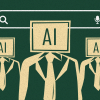AI - the new colleague on your desk

The sudden rise of artificial intelligence in workplaces has sparked both enthusiasm and unease. From language models to workflow automation, AI tools are increasingly integrated into everyday work, promising efficiency and insight. Yet adoption remains uneven, in part because misconceptions abound. Some fear AI will replace human judgment, while others use it superficially, missing its potential to truly enhance productivity. The question is no longer whether to use AI, but how to make it work for you without letting it overstep, and the answer lies in understanding both the capabilities and limitations of these tools and integrating them thoughtfully into workflows.
In order to understand this better, I caught up with professionals across different industries, and realised that there is a common theme: AI is at its best when treated as a thought partner, not a substitute for human judgment. It is less about letting machines run the meeting and more about clearing enough mental space so the meeting is worth having in the first place. "As a consultant, I find AI particularly valuable for brainstorming ideas, initial problem-solving, proofreading, and enhancing the quality of my written outputs," says Sadid Murshed, Associate at Boston Consulting Group. "We use a variety of AI tools, ranging from publicly available platforms like ChatGPT to proprietary software such as Deckster, which specifically aids in creating and refining presentation slides. However, I firmly believe AI should serve primarily as a supportive thought partner and not for generating client deliverables from scratch."
For all the grand predictions, the most common uses of AI in the workplace are surprisingly practical. People use it to summarise meetings, structure emails, draft presentation outlines, or help teams think visually when time is short and AI excels in areas where structure, language, and patterns intersect. "It helps save time on something that is not very strategic to begin with," explains Ashraful Shabab, Talent Partner at Unilever Bangladesh Limited. "I use it to redraft meeting minutes or build on the base of presentation decks; basically, tasks that we can now handle much faster using Microsoft Copilot or ChatGPT. It is not revolutionary, but it frees up bandwidth to focus on the real decisions." Platforms like HiredScore or Taira allow HR teams to sift through hundreds of profiles against job descriptions in minutes, a process that once consumed entire afternoons. Nonetheless, career roadmaps, succession planning, and stakeholder conversations still demand human nuance. "Those are things I do not think AI can help with in a detailed manner as of yet. You need to actually have context, generate conversations, and build models yourself," Shabab adds.
One thread connecting all these conversations is the shift from replacement to augmentation. The strongest users do not hand over their work to AI; they hand it their rough drafts, half-formed ideas, or background clutter and reclaim their thinking time. "We are trying to establish that AI augmentation is the way forward," says Ishmam Chowdhury, COO at Shikho. "For example, we do regular management meetings where we discuss action points for each department. With AI, the time spent behind making slides is replaced by time spent thinking. There is no shame if you used AI to prepare something because what matters is that you still had to think about the analysis and the right prompt." Tools like ChatGPT can draft reports, generate email templates, or offer brainstorming prompts. Automation platforms like Zapier or Microsoft Power Automate streamline repetitive workflows, moving data between apps or scheduling tasks automatically. Even AI-powered analytics tools can surface insights from datasets that would take hours to interpret manually. The strength of AI lies not in replacing expertise, but in augmenting it, thereby giving professionals more time to focus on strategy, creativity, and judgment.
AI thrives in areas where structure and language meet, drafting, brainstorming, summarising, and refining ideas. It can help you prepare a report outline, generate talking points for a presentation, or refine a proposal's tone. However, the output is only as good as the input. Mahir Hossain, Next Business Leader at Grameenphone, explained a formula quite succinctly. "I use AI for SCTA – structure, create, transform, and ask," he said. "It helps me break down complex ideas, draft initial structures for communication, transform existing content to match different stakeholders, and even ask smarter questions when I am exploring something new." This goes on to show how AI responds best when you do not just tell it to do something, but involve it in the process of thinking. Equally important is learning when not to rely on it. ChatGPT cannot replace critical thinking, decision-making, or nuanced expertise. It is a starting point, not an endpoint. Professionals who outsource their thinking entirely risk producing polished but hollow work.
So, does ChatGPT make work easier? In many cases, yes, if paired with clarity, critical thinking, and ownership. It will not make your decisions for you, nor should it. But it can help you make better decisions faster, and perhaps with less friction. The skeptics, often with good reason, warn of overreliance. And yet, the people already integrating AI with care are not naive about these concerns. They are, if anything, more conscious of them. And that, ultimately, might be the real skill of this new era: not prompt engineering in isolation, but editorial control over your own workflow. Knowing which corners can be cut and which must remain hand-carved. Knowing that even as these tools get better, faster, and eerily more persuasive, your judgment takes the point. As this tide of AI-driven assistance spreads, what seems more likely is a recalibration. The work that is rote becomes lighter. The work that is creative becomes faster. And the work that is strategic? It stands out even more.

 For all latest news, follow The Daily Star's Google News channel.
For all latest news, follow The Daily Star's Google News channel. 








Comments